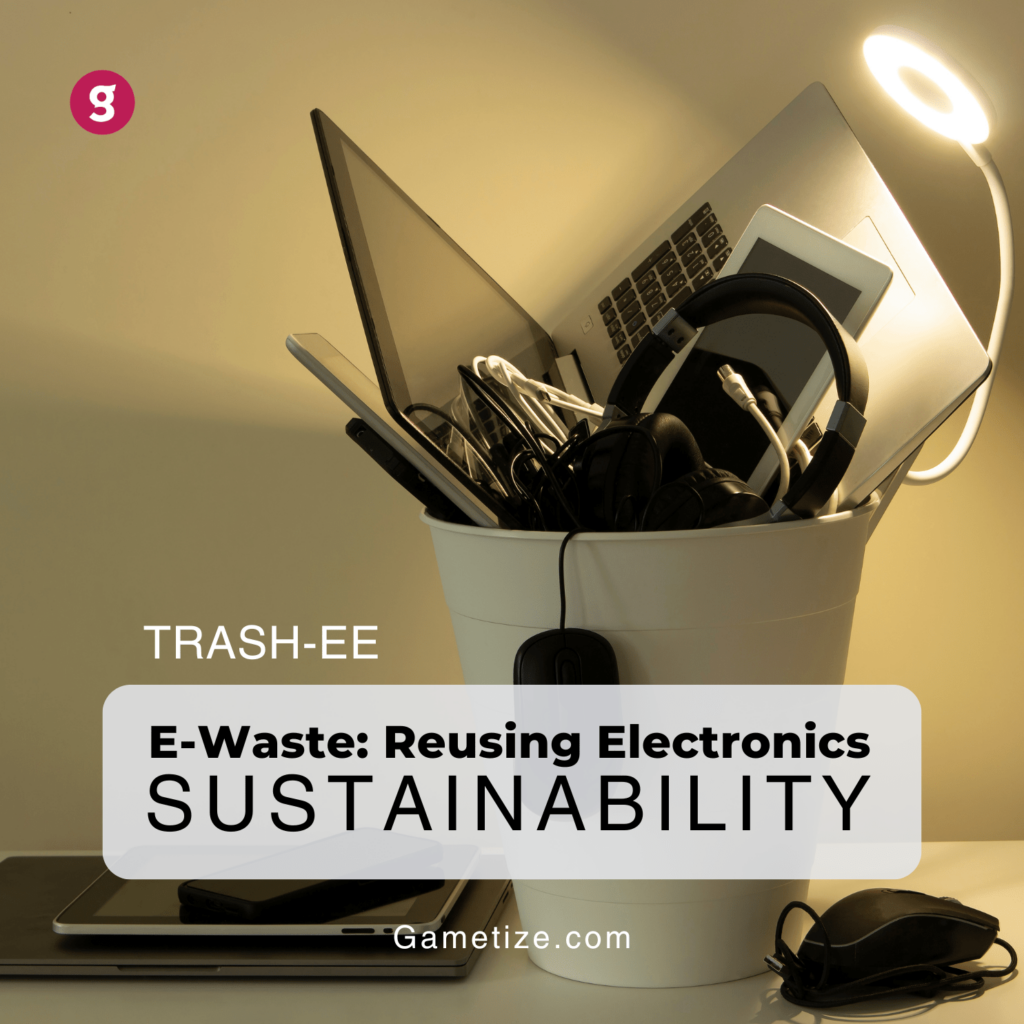Sustainability Series: Trash-EE
Our team’s topic is about electronic waste. This article contains the key points of our 6D playbook, our inspirations for this project and the lessons our team has learnt in this project.
1. Highlighting 6D Playbook
Define the Problem
We came up with our problem statement by focusing on a micro aspect instead of something macro. We narrowed down to how the problem is the lack of awareness and habit among Singaporeans, and how they do not know how to deal with all these electronics, resulting in improper disposal and the increase in electronic waste.
Determine Goals
We determined our goals to be enhancing positive and sustainable behaviours, such as reusing electronics and recycling e-waste in Singapore. However, since aiming everyone to change their mindset on e-waste isn’t easy, we did a more realistic approach. We wanted to use Gametize to educate and create challenges for our audience to be more aware on how to handle e-waste.
Decide Target Behaviours and Emotions
We decided the target behaviours and emotions by thinking about how we wanted to influence their mindsets and emotions after they participate in the game. We thought that it needed to make an impact on how they feel and thus decided that firstly, they should feel worried about the situation after we educate them regarding the reality of e-waste. It should also make them feel motivated to make a difference personally and spread awareness. In a sense, we wish to influence them to form these habits of properly handling the electronics through this game and most importantly, for them to understand through the education given. These can hopefully be done through all our in-app challenges.
Describe and Profile Players
We described and profiled our players according to their ages, occupation and their current behaviour regarding electronics etc. We wanted the profiles to be as relevant as possible to the audience. We were aware that family units in particular consume lots of electronics, and hence the majority of our personas were working parents living with their children. Apart from the usual household appliances, there would be multiple people in the family using various smart devices with a high replacing rate.
Design Gamification Strategy
We decided to do a 7-day campaign where our audience are brought along to be aware of the persisting issues of electronic waste and methods to mitigate such waste. We came up with a storyline where the audience are in first person point of view, and we have a “grim reaper” as a guide through the seven days.
Diagnose and Analyse Content
We think that the game itself is effective in a niche way. It is neither really capable of making all of Singapore aware of the e-waste problem, nor will it miraculously slash the e-waste generation rate by half, but it will definitely reach our target audience. As the issue on electronic waste continues to be an ongoing issue, we think that having this 7 day-campaign is short yet sufficient for people to be educated on e-waste and how we can do our part to solve the issue.
2. Inspiration for this Project
Our inspiration for this game and topic came about because we were thinking how e-waste is such a pressing issue but not enough people are talking about it. We wanted to expand on a topic that not is not as popular. After doing some secondary research, we realised that it is actually a real-world challenge that we are facing right now. E-waste is a problem that is significant in Singapore right now as we actually generate more than 60,000 tonnes every year.
Recycling rates and e-waste handling awareness are not prominent despite the multiple efforts done by the government and some companies through different campaigns. We believe that even though we will not be able to make a big impact on the macro issue, this game will be able to address a smaller part of the real-world challenge by targeting individuals and raising the awareness regarding this increasingly alarming issue.
3. Our Learnings
Throughout the course of this project on electronic waste, We have gained a profound awareness of the far-reaching implications of our electronic consumption habits, and learning about the staggering volumes of e-waste generated annually and the hazardous materials it contains has been eye-opening. The environmental repercussions, from soil and water contamination to air pollution, underscore the urgency of responsible e-waste management. Improper e-waste disposal is equally problematic are the health and social consequences, particularly in communities affected by improper recycling practices.
It’s clear that individuals, businesses, and governments all share responsibility for addressing this issue. We are inspired to take action, whether through reducing personal e-waste, supporting responsible recycling initiatives, or advocating for stronger e-waste policies. This project has taught us that our collective efforts are essential in shaping a sustainable and responsible future in the face of the growing electronic waste problem. In Singapore’s context, it is actually easy to do our part in contributing to reducing e-waste efforts. Singapore has many avenues for recycling and disposing e-waste, hence people need more awareness about such measures to contribute.
You should use this template if you are committed to promoting sustainability in modern Singapore corporate settings, starting from your most abundant resource: Electronics.
This is an awesome template because it serves as a powerful catalyst for positive change, where sustainability is not just a buzzword but a core value that shapes the future of businesses, making them more responsible, ethical, and resilient, ensuring a greener, brighter future for Singapore and the world.
Credits: [AY2023/24] G3 Team 2 – Christopher Loo Wei Jung, Chua Ying Xi, Jill, Errikk Kian Nicdao Mantaring, Kylie Teong Li Ying, Nicholas Leonardo Boentoro, Ooi Wen Xian, Thay Rui Ying


